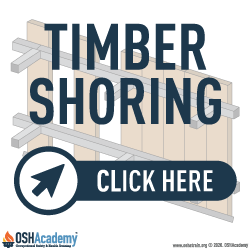Shoring Systems
A shoring system is a structure such as a metal hydraulic, mechanical or timber shoring system that supports the sides of an excavation and which is designed to prevent cave-ins. Shoring or shielding is used when the location or depth of the cut makes sloping back to the maximum allowable slope impractical.
Timber Shoring. Timber shoring systems are very versatile since they are custom built to fit the trench. Deep and long trenches are probably better suited to timber shoring than any other form of protective system. It is suited well for excavations where significant time is to be spent in one area.
Hydraulic Shoring. This seems to be more of a trend today. Hydraulic shoring, a pre-fabricated strut and/or wale system made from aluminum or steel. Hydraulic shoring provides a critical safety advantage over timber shoring because workers do not have to enter the trench to install or remove hydraulic shoring. All shoring should be installed from the top down and removed from the bottom up. Hydraulic shoring should be checked at least once per shift for leaking hoses and/or cylinders, broken connections, cracked nipples, bent bases, and any other damaged or defective parts.
Pneumatic Shoring. Pneumatic shoring works in a manner similar to hydraulic shoring. The primary difference is pneumatic shoring uses air pressure in place of hydraulic pressure. However, you need to have an air compressor on site when using pneumatic shoring. Compressed air is used instead of hydraulic fluid to expand the trench jacks into position.
Screw Jack systems. Screw jack systems differ from hydraulic and pneumatic systems in that the struts of a screw jack system must be adjusted manually. This creates a hazard because the worker is required to be in the trench in order to adjust the strut. In addition, uniform "preloading" cannot be achieved with screw jacks, and their weight creates handling difficulties.
Single-Cylinder Hydraulic Shores. Shores of this type are generally used in a water system, as an assist to timber shoring systems, and in shallow trenches where face stability is required.
Underpinning. This process involves stabilizing adjacent structures, foundations, and other intrusions that may have an impact on the excavation. As the term indicates, underpinning is a procedure in which the foundation is physically reinforced. Underpinning should be conducted only under the direction and with the approval of a registered professional engineer.
Designs of support systems, shield systems, and other protective systems shall be selected and constructed by the employer or his designee and shall be in accordance with the requirements of paragraph (c)(1); or, in the alternative, paragraph (c)(2); or, in the alternative, paragraph (c)(3); or, in the alternative, paragraph (c)(4) as follows:
- (1) Option (1)-Designs using appendices A, C and D. Designs for timber shoring in trenches shall be determined in accordance with the conditions and requirements set forth in appendices A and C to this subpart. Designs for aluminum hydraulic shoring shall be in accordance with paragraph (c)(2) of this section, but if manufacturer's tabulated data cannot be utilized, designs shall be in accordance with appendix D.
- (2) Option (2)-Designs Using Manufacturer's Tabulated Data.
- (i) Design of support systems, shield systems, or other protective systems that are drawn from manufacturer's tabulated data shall be in accordance with all specifications, recommendations, and limitations issued or made by the manufacturer.
- (ii) Deviation from the specifications, recommendations, and limitations issued or made by the manufacturer shall only be allowed after the manufacturer issues specific written approval.
- (iii) Manufacturer's specifications, recommendations, and limitations, and manufacturer's approval to deviate from the specifications, recommendations, and limitations shall be in written form at the jobsite during construction of the protective system. After that time this data may be stored off the jobsite, but a copy shall be made available to the Secretary upon request.
- (3) Option (3)-Designs using other tabulated data.
- (i) Designs of support systems, shield systems, or other protective systems shall be selected from and be in accordance with tabulated data, such as tables and charts.
- (ii) The tabulated data shall be in written form and include all of the following:
- (A) Identification of the parameters that affect the selection of a protective system drawn from such data;
- (B) Identification of the limits of use of the data;
- (C) Explanatory information as may be necessary to aid the user in making a correct selection of a protective system from the data.
- (iii) At least one copy of the tabulated data, which identifies the registered professional engineer who approved the data, shall be maintained at the jobsite during construction of the protective system. After that time the data may be stored off the jobsite, but a copy of the data shall be made available to the Secretary upon request.
- (4) Option (4)-Design by a registered professional engineer.
- (i) Support systems, shield systems, and other protective systems not utilizing Option 1, Option 2 or Option 3, above, shall be approved by a registered professional engineer.
- (ii) Designs shall be in written form and shall include the following:
- (A) A plan indicating the sizes, types, and configurations of the materials to be used in the protective system; and
- (B) The identity of the registered professional engineer approving the design.
- (iii) At least one copy of the design shall be maintained at the jobsite during construction of the protective system. After that time, the design may be stored off the jobsite, but a copy of the design shall be made available to the Secretary upon request.
(a) Scope. This appendix contains information that can be used when timber shoring is provided as a method of protection from cave-ins in trenches that do not exceed 20 feet (6.1 m) in depth. This appendix must be used when design of timber shoring protective systems is to be performed in accordance with 1926.652(c)(1). Other timber shoring configurations; other systems of support such as hydraulic and pneumatic systems; and other protective systems such as sloping, benching, shielding, and freezing systems must be designed in accordance with the requirements set forth in 1926.652(b) and 1926.652(c).
(b) Soil Classification. In order to use the data presented in this appendix, the soil type or types in which the excavation is made must first be determined using the soil classification method set forth in appendix A of subpart P of this part.
(c) Presentation of Information. Information is presented in several forms as follows:
- (1) Information is presented in tabular form in Tables C-1.1, C-1.2 and C-1.3, and Tables C-2.1, C-2.2 and C-2.3 following paragraph (g) of the appendix. Each table presents the minimum sizes of timber members to use in a shoring system, and each table contains data only for the particular soil type in which the excavation or portion of the excavation is made. The data are arranged to allow the user the flexibility to select from among several acceptable configurations of members based on varying the horizontal spacing of the crossbraces. Stable rock is exempt from shoring requirements and therefore, no data are presented for this condition.
- (2) Information concerning the basis of the tabular data and the limitations of the data is presented in paragraph (d) of this appendix, and on the tables themselves.
- (3) Information explaining the use of the tabular data is presented in paragraph (e) of this appendix.
- (4) Information illustrating the use of the tabular data is presented in paragraph (f) of this appendix.
- (5) Miscellaneous notations regarding Tables C-1.1 through C-1.3 and Tables C-2.1 through C-2.3 are presented in paragraph (g) of this Appendix.
(d) Basis and limitations of the data.
(e) Use of Tables.
(f) Examples to Illustrate the Use of Tables C-1.1 through C-1.3.
(g) Notes for all Tables.
All shoring should be installed from the top down and removed from the bottom up. Hydraulic shoring should be checked at least once per shift for leaking hoses and/or cylinders, broken connections, cracked nipples, bent bases, and other damaged or defective parts.
Knowledge Check Choose the best answer for the question.
4-5. Which critical safety advantage does hydraulic shoring have over timber shoring?
You forgot to answer the question!


